 |
|

|
 |
TABLE of CONTENTS
 |
Monarch Highway proposed for I-35 Corridor from Mexico to Minnesota |
By Judy Jacobs
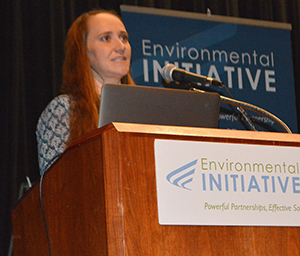
Tina Markeson, Roadside Vegetation Management Unit supervisor, recently presented and participated in a panel discussion about roadside management best practices at the recent Pollinatorís Summit. Photo by Judy Jacobs |
President Obama in 2015 released a federal strategy for bees, beetles, butterflies and other pollinators that called for federal agencies to explore an Interstate 35 Pollinator Corridor, particularly with state department of transportations from Minnesota to Texas. As part of the strategy, there is a goal to restore, enhance or create seven million acres of land for pollinators over the next five years. Pollinators such as honey bees, native bees, butterflies, moths, beetles, flies, wasps and hummingbirds are responsible for approximately one-third of the food people eat. Native and honey bees pollinate 70-80 percent of flowering plants in the Midwest.
Commissioner Charlie Zelle was in Washington, D.C., Feb. 25 to meet with White House staff and representatives from the Federal Highway Administration and Iowa, Oklahoma, Missouri, Kansas and Texas DOTs. At the top of their agenda was using the Monarch Highway as a brand for external marketing and identifing state DOT guidelines to attract external resources to support state highway native vegetation.
“There is power in collaboration,” said Zelle. “As commissioner I’ve learned that people care about livability. It’s important that we take the initiative to think outside the box when it comes to managing our roadside vegetation carefully.”
The I-35 Corridor is dubbed the Monarch Highway because of the 3,000-mile migration of monarchs between Mexico and Minnesota annually. The focus of this program is to restore native vegetation that pollinators thrive on, including 200,000 acres along the corridor.
During the last 20 years, the monarch population has decreased by 90 percent due mainly to the loss of the milkweed plant that serves as both a food source and breeding ground for monarchs. Without any action to preserve them, these pollinators will cease to exist.
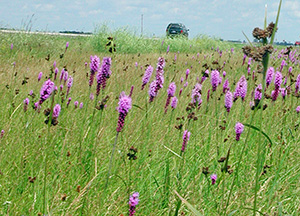
Mowing or prescribed burning of grasses and noxious weeds in the spring can produce prairie flowers and provide habitat for pollinators. Photo courtesy of Environmental Services |
Pollinators need areas of diverse plant species, which bloom at different times throughout the growing season, to thrive. Some pollinators have species-specific needs to complete their life cycle. Monarch larvae thrive on milkweed and swallow tail larvae need plants in the parsley family to flourish and grow. And, different pollens have different nutritional values.
“There are some limitations, but also some real potential for roadsides to serve as pollinator habitat,” said Tina Markeson, Roadside Vegetation Management Unit supervisor. “Road authorities are often seen as both the problem and solution to pollinator troubles—that we’re harming pollinators by mowing and applying herbicides and have all this potential habitat that could be a refuge for pollinators—but neither is completely true.”
“Roadside habitat is a small percentage of the habitat that has been lost. It has be to everyone working together to solve this problem,” said Markeson. “A diverse landscape not only provides forage for pollinators, but also limits the growth of invasive species and reduces long-term maintenance costs.”
MnDOT has worked to restore native plantings along roadsides for more than 25 years. In the process, the agency developed seed mixes with a variety of seeds that flower at different times, allowing for a continuous and diverse food source for pollinators.
A variety of tools were developed for project designers to use to determine and implement viable roadside maintenance practices. They include:
- Plant Selector - This application allows designers to input site and desired plant characteristics and receive a list of individual plants or seed mixes that will work on a particular site or project. This also includes where the plantings are located on the roadside profile. www.mndot.gov/roadsides/plantselector/
- MnDOT’s Seeding Manual – MnDOT partnered with the Minnesota Department of Natural Resources and the Board of Water and Soil Resources to establish 33 state base mixes. This leads to less confusion and better availability from commercial vendors. www.mndot.gov/environment/erosion/pdf/seedingmanual.pdf
- MnDOT Vegetation Letters – Memos to designers to aid in seed mix selection, fertilizer and temporary cover specific to their region. www..mndot.gov/environment/erosion/seedmixes.html
“A decline in pollinators affects us all,” Markeson said. “Reversing this trend is important to the ecosystem and to human health and well-being. We need to continue to work with state and federal agencies to partner on pollinator opportunities and to explore opportunities to partner with adjacent landowners to extend native planting efforts onto the right of way.”
Currently, efforts are under way to explore how to implement best management practices for pollinators along Minnesota roads. MnDOT is also working with other state agencies to explore partnering opportunities. |
 |
|

|
 |
TABLE of CONTENTS
 |
Weigh station video provides an inside view of weight enforcement operations |
This video gives viewers an inside look at the operations of a Minnesota weigh station. It shows the key role that weight enforcement plays in protecting the stateís roadway infrastructure and protecting motorists from unsafe vehicles and unqualified drivers. Video produced by Video Services |
|
 |
|

|
 |
TABLE of CONTENTS
 |
Employees use vending machines to get their supplies |
|
By Sue Roe
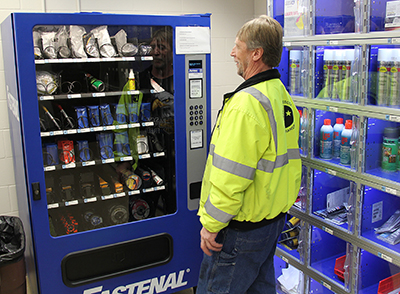
Pat Peopping, District 3 Building Services, checks out the items in the inventory vending machine at the St. Cloud building. Smaller items are available in the traditional looking vending machine and larger items are available in a locker-type machine. Photo by JP Gillach |
Vending machines take on a new meaning in some of the districts’ truck stations and shops. The traditional ones dispensing drinks and snacks are still there, but there are others that offer gloves, paint, earplugs and an assortment of other “fast moving” items for maintenance, construction and shop employees.
“We use them for anything used on a regular basis, primarily consumables,” said Kelvin Smith, District 3 shop supervisor.
The inventory vending machines, which were installed last year when the St. Cloud Inventory Center was remodeled, are as easy to use as an employee entering in his or her employee ID number, entering the quantity needed and pushing the button for the desired item. There’s an assortment of items ranging from drill bits, spray paint, window cleaner and duct tape. The vending machine currently has about 40 items. There are also locker-size vending machines that dispense up to 48 bigger items.
When employees enter their ID number and push the button for the item, the information is sent to the vending machine owner for replacing and inventorying the items. A weekly report of the items used is also provided to the inventory and shop supervisors.
The idea was first introduced in the Metro District’s Central Shop three years ago. There are two machines at Central Shop. One is on the maintenance side, where safety glasses, zip ties and lubricants are stocked. The other is on the electrical services side, where the stock includes batteries, wire, tape, silicon, sunscreen, insect repellent and windshield washer.
Employees used to get their items at the inventory center but there wasn’t a person just assigned to check out the equipment.
“The employees who work in the back are doing other things and not waiting for someone to show up to check out an item,” said Brian McDonald, transportation materials supervisor at Central Shop/Fort Snelling. “Because of the variety of work we do, there isn’t always a person in the inventory center. That would make the mechanic or electrician have to wait for someone to show up and check out the item.”
To check out an item, an employee entered the information into the computer before the other employee could take the item. That could take a few minutes to get the right information entered in the right location on the form.
Now, the employee can go to the vending machine, get the item and return to work within a minute, McDonald said.
The vending machines are also beneficial for employees who are on call or work weekends and need items to do their work, he said.
There’s also an accountability factor, McDonald said. Sometimes items such as tools were checked out but not checked back in right away, so when other employees needed them, they had to take time to find out where they were located.
Inventory vending machines are also used in District 8 in Willmar and Marshall, and in the Metro District in Maple Grove. |
 |
|

|
|

|
 |
TABLE of CONTENTS
 |
Metro State Aid takes big steps to reduce its global footprint |
|
By Judy Jacobs
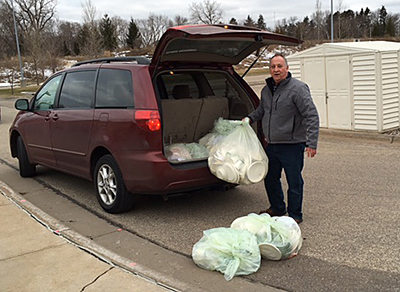
Jim Deeny, Metro State Aid, loads his vehicle to take compostable waste to the Ramsey County organic recycling site in Mounds View. Photo by Elisa Bottos |
At the recent Metro State Aid construction administration training held at the Ramsey County Public Works building in Arden Hills, Metro District employees, who hosted the event, worked hard to ensure that the seminar was almost zero waste. Event planners supplied compostable dinnerware for participants’ breaks and lunch. Ramsey County’s Environmental Office supplied free compostable event bags to help support their efforts.
“We paid an extra dollar per person for the caterer to supply us with compostable dinnerware,” said Sharon LeMay, state program administrator principal. “We knew our initial effort as a Zero Waste Event would not run as smoothly as we would have liked since the public works building doesn’t offer compost recycling and we couldn’t afford to have a hauler pick it up.”
But that didn’t thwart their efforts. Jim Deeny, engineering specialist senior, loaded the bags in his van and took them to the Ramsey County organic recycling site in Mounds View.
“It turned out to be more of an almost zero-waste event and we learned a few lessons,” LeMay said. “There were condiments and creamer in non-recyclable packets, as well as salty snacks in individual serving packs that couldn’t be recycled. The caterer also used toothpicks with frilly tops on the sandwiches and those, too, could not be recycled. But we did recycle everything else. I’d say what didn’t get recycled would fit into a brown paper lunch bag.”
Next year the organizers will look at using reusable condiment containers, serving salty snacks in a large reusable bowl with a spoon and individual compostable bowls and asking the caterer to not use toothpicks.
Why use compostable?
Landfill space is limited and unsustainable. While municipal solid waste generation rates have increased, the capacity to handle these materials has declined in many areas of the country. Many landfills are closed because they are full; others are near capacity with no room to grow.
Currently, 33.8 percent of municipal solid waste in the U.S. is recovered and recycled or composted, 11.9 percent is burned at combustion facilities, and the remaining 54.3 percent is disposed in landfills.
In 2009, the EPA estimated that waste from commercial and institutional locations, such as schools, hospitals and businesses, amounted to 35 to 45 percent of municipal solid waste. Containers and packaging made up the largest portion of municipal solid waste generated — almost 30 percent or about 72 million tons.
Using compostable plates offers a variety of benefits. Compostable plates are constructed of natural resources that are bio-based, which means that they will break down to virtually nothing that is visible to the human eye. They won’t leave trash that causes litter. The types of agricultural crops that compostable plates tend to be made out of include sugarcane, grass, bamboo and corn.
Institutions that use compostable plates are able to do their part to support the environmentally friendly Green movement and to protect the environment. Compostable dinnerware is competitively priced to make them just as affordable as other types of plates that aren’t compostable.
“I strongly encourage each MnDOT district, department and office to consider using compostable materials for their future meetings,” LeMay said. “This is another opportunity for MnDOT to show that we care about sustainability and are making efforts to give back to our local communities and the environment.” |
 |
|

|
 |
TABLE of CONTENTS
 |
Kevin Western selected as new state bridge engineer |

Kevin Western began as the new state bridge engineer Feb. 24. Photo courtesy of the Bridge Office |
Kevin Western was selected as the state bridge engineer and took over the reins Feb. 24. Western takes over this role from Bev Farraher, who was the acting state bridge engineer over the last year. Farraher is moving to a new position with the city of St. Paul as their operations manager.
“My sincere thanks go out to Bev for the strong leadership she provided to the Bridge Office over the last year,” said Nancy Daubenberger, assistant commissioner for Engineering Services.
Western has 29 years of experience in bridge design, standards and construction. He was the major bridge projects design manager, working on such projects as the St. Croix River Crossing, the Hwy 53 Realignment and the Red Wing Bridge. He also served as assistant state bridge engineer in charge of the design area and was the deputy project manager for design on the Interstate 35W Bridge project.
“Kevin brings an excellent background to the position, in the areas of bridge design, standards and construction, said Daubenberger. “Kevin provided much support to the Bridge Office as we worked to rebuild the public’s trust and confidence in MnDOT after the I-35W Bridge collapse. He has developed himself over the years as the go-to person in technical areas related to bridges. I’m excited to work with him as the state bridge engineer, and I’m confident he will advance the Bridge Office in this new leadership role.”
Western serves as vice-chair of the American Association of State Highway and Transportation Officials Bridge T-13 culvert committee. He holds a master of science degree in structures from the University of Minnesota and a bachelor of science degree in civil engineering from the University of Wisconsin.
Western is located at the Bridge Office in Oakdale and can be reached at 651-366-4501. |
 |
|

|
 |
TABLE of CONTENTS
 |
Jay Hietpas named Office of Traffic, Safety and Technology director |
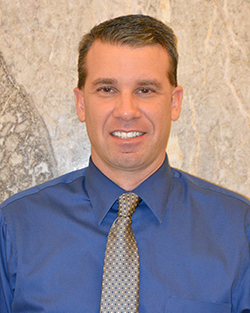
Jay Hietpas will take over as the director of the Office of Traffic, Safety and Technology March 9. Photo by Rich Kemp |
Jay Hietpas was selected as the director for the Office of Traffic, Safety and Technology, effective March 9. Hietpas has 20 years of experience, both at MnDOT and as a consultant. He currently serves as the project management unit leader within the Office of Project Management and Technical Support.
“Jay has recently been providing excellent leadership to our department project management battle and innovative contracting, and I look forward to working with him in his new role,” said Mike Barnes, assistant commissioner for operations.
His career includes managing the innovative contracting unit within the Office of Construction and Innovative Contracting, which includes the Work Zone Safety and Automation units. As a consultant, he led the firm’s traffic engineering unit, which included traffic analysis, signal design, signing design, work zone/staging designs, roundabout design, and traffic impact analysis studies. Hietpas also has experience as a MnDOT’s design-build program manager, a construction project engineer, a design engineer, and a pre-construction engineer.
Hietpas has a bachelor’s degree and master’s degree in civil engineering from the University of Minnesota.
“Please join me in welcoming Jay to this position and thanking Ray Starr for his support in the acting position the last few months,” said Barnes.
Hietpas can be reached at Waters Edge in Roseville and at 651-234-7004.
|
 |
|

|
 |
TABLE of CONTENTS
 |
Ombudsman, Customer Relations Offices merge |
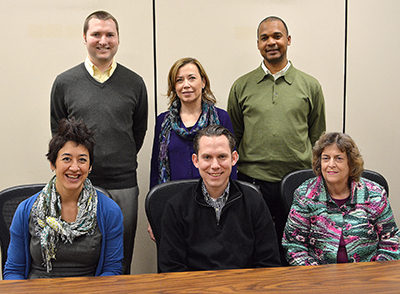
Forming the Public Engagement and Constituent Services Office are (front row from left) Sarah Rudolf, public engagement coordinator; Jim Skoog, assistant Ombudsman; Laurel Janisch; customer response coordinator; (back row from left) Ben Lowndes, deputy Ombudsman; Jeanne Aamodt, customer relations manager; and Richard Davis, acting office director. Photo by Rich Kemp |
The Customer Relations and Transportation Ombudsman offices are combining to form the Public Engagement and Constituent Services Office.
Both offices have complementary missions that inform, solicit feedback and respond to changing customer priorities and concerns. They both support MnDOT districts and specialty offices to effectively meet people where they are, identify what is important to them, help resolve conflicts and ensure MnDOT's transportation system decisions are better informed through on-going market research, strong public involvement and the feedback the agency receives (both concerns and compliments).
“Although there are many benefits from merging these offices, we plan to take the next six months to evaluate how well this new structure works in practice before making permanent assignments,” said Eric Davis, chief of staff.
Current Transportation Ombudsman Richard Davis will serve as the acting office director of this newly merged office. He worked closely with Karla Rains, former Customer Relations director, prior to her departure and will continue to work closely with the staff of both offices as well as partners throughout MnDOT to help ensure a smooth transition.
“We thank Karla Rains for the leadership she provided to Customer Relations Office before leaving for a new opportunity in the private sector,” said Davis.
"We are fortunate to have a leader with Richard’s background and professional experience in both the public and private sector to step in and lead this newly merged office," said Davis. "Richard has served as a consultant with Deloitte and has held leadership roles in both marketing and communications at Target, Thomson Reuters, and Supervalu. Just prior to joining MnDOT, Richard was Chief Communications Officer for Richmond Public Schools in Virginia. In addition to serving as the district’s primary spokesperson, Richard executed multi-channel engagement, outreach and information-sharing strategies." |
 |
|

|
 |
TABLE of CONTENTS
 |
Program plays key role in preserving historic bridges |
By Judy Jacobs
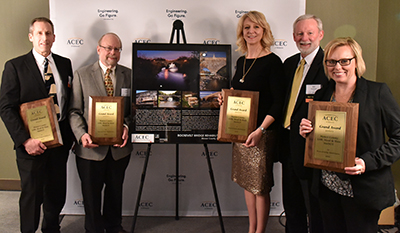
ACEC award recipients (from left to right) Joe Litman, LHB engineer; Bob Frame, Mead and Hunt historian; Kristen Zschomler, MnDOT CRU; Bill Bennett, LHB, and Krista Pascoe, LHB. Photo courtesy of ACEC |
Historic bridges represent America’s engineering heritage. In 1966 Congress enacted the National Historic Preservation Act to help preserve historical and archaeological properties, including bridges. MnDOT’s Historic Bridge Program was created as a result of this act and serves to preserve the historic bridges in Minnesota and streamline program delivery. The program is a partnership between MnDOT's Cultural Resources Unit, State Aid Division, Bridge Office and local bridge owners in townships, cities and counties.
In Minnesota there are almost 19,000 bridges; only 230 of which are “historic.” To be historic, a bridge must have significance, typically in the areas of engineering or aesthetics, or have an association with important transportation projects, and retain integrity. Local agencies control over 60 percent of the historic bridges in Minnesota. MnDOT provides guidance to local agencies on best practices for maintaining and preserving their historic bridge(s), and oversees the federal review process that affords protection to these bridges. Currently identified historic bridges, both state and locally owned, can be found on the historic bridges website.
Local bridge owners rely on State Transportation Bond Funds to leverage local, State Aid Local Transportation and federal funds when replacing or rehabilitating bridges.
“Historic bridges are a unique subset of these projects, often requiring specific expertise in both design and construction which ultimately may increase the cost to rehabilitate them,” said Patti Loken, State Aid programs engineer. “Local bridge replacement bond funding appropriated through the Legislature impacts all local bridge owners and everyone benefits from investments in the bridge program.”
“There’s been a major shift in how we think about historic bridges as a statewide resource,” said Loken. “Partnering with the CRU, we’ve been able to build a great working relationship with local townships, cities and counties.”
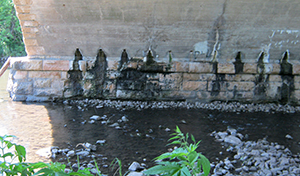
Severe deterioration is seen on the Roosevelt Bridge before the rehabilitation project. The bridge was built in 1933. Photo courtesy of Cultural Resources Unit |
During the past several years, for example, almost 20 locally owned historic bridges have been rehabilitated to historic and engineering standards.
A recent example of successful bridge rehabilitation is the Roosevelt Bridge over the Cedar River in Austin. The bridge was originally built in 1933 as a Civil Works Administration project. The bridge is significant as an intact representation of this short-lived Depression era program, its unusual combination of concrete arches with a masonry substructure, and the high level of craftsmanship of multiple tradesmen involved in the project.
On Jan. 29, 2016 the American Council of Engineering Companies of Minnesota presented a Grand Award to Mower County, MnDOT ‘s SALT and CRU office, consultants LHB and Mead & Hunt for their work on the Roosevelt Bridge, especially considering the challenges of the advanced deterioration. This team will also receive ACEC’s National Recognition Award for Engineering on April 19, 2016 in Washington, D.C.

The Roosevelt bridge is significant for this unusual combination of concrete arches with a masonry substructure. Photo courtesy of Cultural Resources Unit |
The Roosevelt Bridge rehabilitation project followed preservation standards by replacing severely deteriorated stones with new ones that matched the original ones in color texture and installation. Bridge lights and pilasters that were removed many decades ago were reconstructed using historical photographs and drawings as a reference.
“Working on historical bridge project over the years, which have many regulatory and engineering challenges, helped us realize that training for MnDOT staff, local agencies and consultants would be beneficial,” said Kristen Zschomler, supervisor of the CRU and program manager for the Historic Bridge Program. “Five years ago we developed a training program with the Bridge Office and the FHWA. We’ve presented that training in Minnesota four times, but have heard from our partners in other states that they are still struggling with how to deliver historic bridge projects. We are currently working with the National Preservation Institute to develop a nationwide training program model based on our Minnesota example as part of a larger effort to help others understand how to preserve and repair historic bridges.”
The first NPI Historic Bridge session will be April 27-28 at the Arden Hills Training Center. For more information, or to register for the class, visit www.npi.org/sem-bridge.html. Minnesota residents will have their registration fees waived. |
 |
|

|
 |
TABLE of CONTENTS
 |
Whatís new on the web |
New Library webpage contains AASHTO digital files
AASHTO, a major publisher of transportation and engineering-related handbooks, manuals, standards and specifications, is transitioning to digital-only publishing. The MnDOT Library manages these publications and provides access and communication of their release.
In the past, the library received and distributed 10 print copies of certain AASHTO publications. With the move to digital-only format, the department now receives five licenses for concurrent, agency-wide access. This means that five MnDOT staff will be able to access the publication simultaneously. If a sixth person tries to access the publication, they will receive the message, “Allowed limit of users logged in has exceeded.” Sessions will time-out after 20 minutes of inactivity.
To facilitate access to AASHTO digital-only publications, the library created an iHub page located in the A-Z directory under AASHTO Digital Publications. This page includes a PDF document with directions and screen shots to help employees access the digital publication. The document also includes a shared account name and password that can be used by all employees
Under the terms of the licensing agreement, only MnDOT employees are allowed to access and use AASHTO digital publications. Third parties, such as consultants, will need to obtain their own license to access and use AASHTO digital publications.
AASHTO’s first digital-only publication, “Pavement Design, Construction, and Management: A Digital Handbook,” is now available.
For questions or comments, contact the MnDOT Library at library.dot@state.mn.us or 651-366-3791, or submit via webform.
Report wrongdoing form
It’s important for the department to maintain a high standard of conduct and level of scrutiny. A report wrongdoing form exists on ihub to provide a confidential way for employees wishing to report waste, fraud, mismanagement or other types of misconduct. Now employees can access the report wrongdoing form through the external site at mndot.gov/reportwrongdoing, which allows for the privacy and capability to submit on personal devices.
Anyone with information regarding possible wrongdoing involving MnDOT property, assets, personnel, vendors or implementing partners, is strongly encouraged to report the matter through either of the report wrongdoing forms. In submitting your report, please attempt to answer all of the questions to the best of your ability and try to be as specific and as detailed as possible.
|
 |
|

|
 |
TABLE of CONTENTS
 |
MnDOT marks Black History Month |
To celebrate Black History Month, the Office of Equity and Diversity coordinated a video presentation and discussion Feb. 24 highlighting some of the achievements and positive impacts African Americans have made, both nationally and in Minnesota.
“It is important to honor African Americans who made contributions to help make things better for future generations,” said Mary Young, Diversity and Inclusion development coordinator.
During the event, participants responded to the video presentation and shared their experiences as diverse individuals. The following comments are from Toreen Cordova, Resource Management Program, who shared this story during the discussion.
Racism is not born, it is taught
When I was 15 I witnessed racism in the ninth grade. I attended Irondale High School in New Brighton. Our school had roughly just a handful of African Americans. That never mattered though; I can remember other students still treated me kindly.
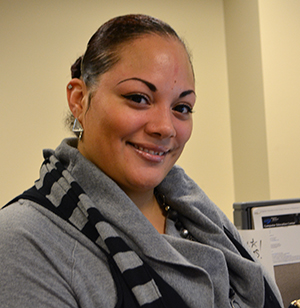
Toreen Cordova, Resource Management Program, spoke about her experiences during the Black History Month event Feb. 24. Photo by Rich Kemp |
One girl in particular—her name was Sam—we became really good friends. We had several classes together and would often hang out in the halls in-between classes and spend our lunch periods together. But when I would ask to hang out with her outside of school or to even just exchange numbers, she would always ignore me or somehow change the subject. It never occurred to me why she avoided the conversation.
So one day, I asked why she ignored me when I brought up exchanging numbers. At that moment she told me we could not be friends outside of school. When I asked why, she replied, “My parents are racist.” She mainly spoke more of her father being this way. She explained to me that if her parents knew we were friends, she would get in trouble.
Now, hearing this for the first time hurt my feelings, however, I wasn’t upset with Sam. Despite her parents’ beliefs, we grew a really close friendship and she never once allowed her parents’ beliefs to come between our friendship, and I will always remember her for that. Instead, she accepted me for who I was and became her own person because she stood up for what she believed in.
I learned a very valuable lesson that day: it doesn’t matter what you look like, or where you come from. That is why it is so important to teach our youth about racism, that we must come together and accept one another for who we are, not for the color of our skin, if we want to be the change that we want to see in this world.
I learned that racism is not born, it is taught. Sam taught me it is possible to overcome the hatred, but it starts with you. I wonder to this day how Sam is doing, where she is in life right now, how are her parents doing, and what changes have been made, if any, since high school. |
 |
|
| |
|



